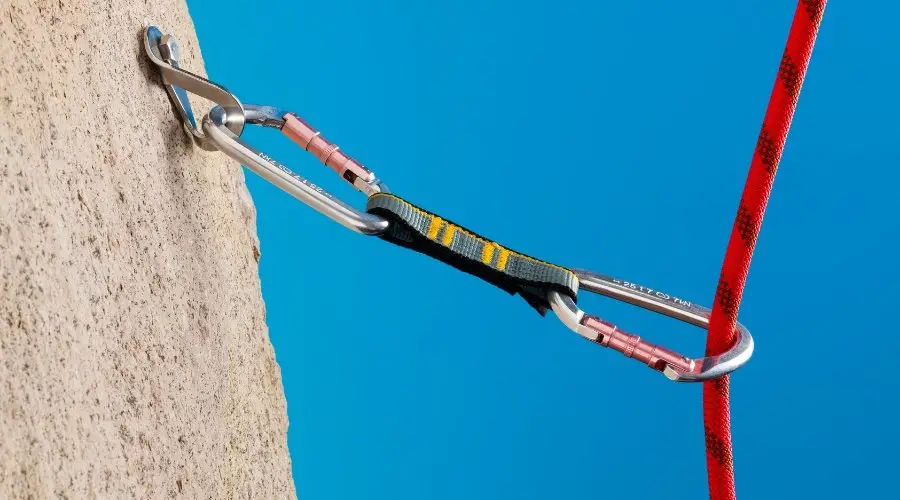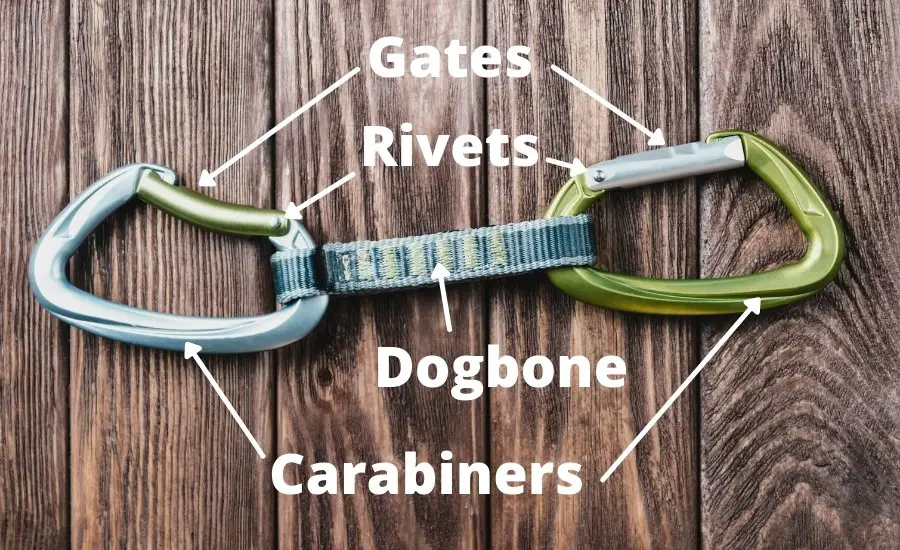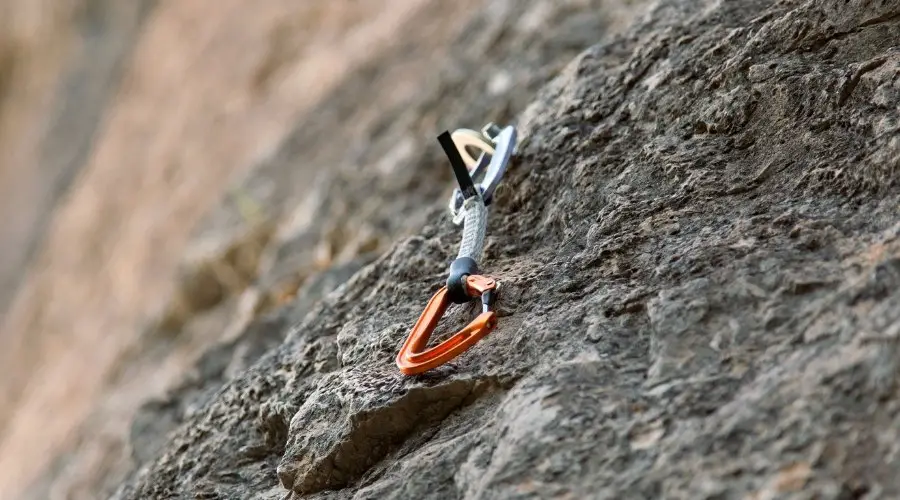Every climber needs to know when it is time to change out their old quickdraws for some new ones. Climbing on worn out draws is very dangerous and can lead to accidents when climbing. To know when exactly to change them out, climbers need to know how long they typically last and signs they are getting worn out.
As a general rule, quickdraws will last approximately 3 to 5 years of moderate use. Replacing the dogbone/sling will extend the quickdraw’s lifespan assuming the carabiners are in good condition. Quickdraws are not safe to use when they are damaged, worn out, or have dogbones over 10 years old.
There are many factors that determine how long a quickdraw will last. Some quickdraws can become dangerous to climb on after a single session while others could last a decade. This article discusses these factors in detail and examines when exactly you need to replace quickdraws.
If you are curious how much the popular quickdraws sets are going for these days, check out their current price on Amazon here!
Expected and Maximum Lifespan of Quickdraws
All quickdraws must meet the specified CE and UIAA safety standards when they are first manufactured. These standards require the quickdraws to have a minimum amount of strength to handle expected forces from falling. This minimum strength is 22kN for the slings/dogbones and 20kN for the carabiners.
These numbers may not mean anything to you. I know when I first heard them I had no idea what they meant in practical application. I found a HowNOT2 YouTube video that tested out how much force is generated from various types of climbing falls. None of the falls they simulated exceeded 5kN of force. You can check this out below:
While quickdraws are required to have a certain strength, they are not required to meet any cyclic loading, uv exposure, or durability requirements. Basically, no requirements exist that specify how long they need to last or how much wear and abuse they need to be able to withstand.
In an effort to quantify how long quickdraws typically last, we need to break them out into their two parts: the dogbone and the carabiner.
Expected and Maximum Lifespan of Dogbones
Dogbones are made from organic textiles (carbon containing materials such as nylon, polyester, and/or ultra-high-molecular-weight polyethylene). As such, these materials decay overtime and will lose their strength.
Most manufacturers recommend replacing dogbones 5 years after their first use or 10 years after their initial fabrication date. Whichever comes first.
That being said, many climbers who frequently use quickdraws will need to replace them before these timeframes. On average, the sling/dogbone of the carabiner will last a climber 3 to 5 years of moderate use with proper care.
While all of these numbers are very conservative, it is your life at stake and you should not want to find the dogbone’s expiration date when climbing. If you are ever in doubt that your equipment is not safe, do not climb on it. The common signs to look for to replace the dogbone/sling are discussed in further detail in the next section : When To Replace Quickdraws.
Expected and Maximum Lifespan of Climbing Carabiners
Unlike the dogbone, carabiners are made from non-organic material (metals such as aluminum and steel). This just means that they will not decay and lose their strength anytime soon if taken care of properly.
To test this out, HowNOT2 did an experiment on YouTube in which they tested the maximum breaking strength (MBS) of 4 old carabiners and 4 new carabiners.
As seen in the video above, there was not a significant difference in the breaking strength between the new carabiners and the old ones. The old carabiners tested were in excellent condition. This result would not have been the same if they were damaged or worn down.
Repeatedly loading metal close to its breaking point and then de-loading it weakens its strength significantly. This is because micro-cracks are formed inside the metal that are unable to be seen. Eventually, these micro-cracks turn into larger cracks that cause the metal to fail. Carabiners are the most susceptible to this when they have taken multiple big falls.
While some have claimed this is a myth, I assure you it is not. Metal is subject to micro-cracks and weakening in these cyclic loading conditions. If you don’t want to take my word for it, you can check it out for yourself here.
Although carabiners do not have a “maximum” lifespan for climbing, they will eventually wear down and become unusable. On average, climbing carabiners will typically last a climber 10-15 years of moderate use with proper care.
As with the dogbone time frame above, this is very conservative. Some carabiners can last way longer than this timeframe but why risk it? You should always be expecting your equipment for defects and retiring it when you find them. Typical reasons and warning signs to replace your carabiners are discussed more in the next section.
When To Replace Quickdraws

As in the section above, we will be splitting the quickdraw into its two components to analyze it: biners and dogbone.
When to Retire Dogbones/Slings
You should always inspect your dogbones before and after every climbing session. This way you will be confident your gear is in the proper condition and can identify any damage as soon as it happens.
You should retire your dogbones/slings immediately if they have any of the following:
- Rips/tears
- Frayed edges
- Fading due to UV exposure
- Discoloration from contact with any fluids
- Fuzziness
- Stiff areas
- Burned or melted areas
- Been involved in very severe fall
When in doubt, always retire the dogbone/sling and use a new one in good condition. They are cheap and easy to replace. Don’t be dumb and climb on potentially dangerous equipment.
If you have realized that you need new dogbones, you can check out my favorite ones on Amazon here.

When to Retire Climbing Carabiners
As with the dogbones above, you should always be inspecting your carabiners before and after every climbing session as well.
You should retire your climbing carabiners immediately if they have any of the following:
- Visible cracks
- A structural deformity (bent, stretched, twisted)
- Loose, bent, or missing rivets
- Improperly functioning gate (after cleaning)
- Improperly functioning locking mechanism (if present)
- Evidence of wearing (grooves, sharp edges, thin areas)
- Has been subjected to water for long periods of time
- Has been in a fire
- Experienced a large drop (such as falling from 50m onto a rock)
- Has been in contact with corrosive fluids (like battery acid in your garage)
When in doubt, always retire your climbing carabiner and use a new one in good condition. These are also cheap and easy to replace like the dogbones/slings.
If you have realized you need to replace your carabiners, you can check out my favorite ones on Amazon here.
Factors that Determine How Long Quickdraws Last
Now that we have covered how long quickdraws can last and when to replace them, let’s discuss what affects their lifespan. To do this, we will be talking about the different parts of the quickdraws as above.
Main Factors Influencing Carabiner Lifespan
In general, there are three main factors that play into the lifespan of carabiners: proper care, amount of wear, and experience of significant events.
Proper Care and Maintenance of the Carabiner
This is perhaps one of the most overlooked categories. Making sure you are keeping your carabiner clean and functioning properly will help extend its lifespan dramatically. For a visual example, check out the video below which walks you through a visual inspection and cleaning of two different biners.
In addition to keeping the biner clean, you will want to make sure it is stored away and not left out on a route. Leaving your biners on a route will invite them to be used by other climbers and will wear out quicker than if they were put in your closet.
Amount of Use and Wear
As discussed above, the repeated loading of the carabiner will wear it down and decrease its lifespan. A study was conducted which tested and compared the carabiner strength of new and worn out carabiners. The results of which can be seen in the quote below.
“Both new and heavily worn karabiners were tested open and closed, and results from static and dynamic tests were compared . . . Irrespective of test type, karabiner strength decreased with wear level. Based on our results, we advise frequent inspection of permanently placed karabiners for signs of excessive wear.”
Schambron, T., Uggowitzer, P.J., “Effects of wear on static and dynamic failure loads of aluminum-based alloy climbing karabiners”
Basically, the more worn out a biner is, the weaker it will be and more likely to fail.
Carabiners That Experience Significant Events
You can think of this category as one-time events that drastically affect the carabiner. These can be anything from the biner getting covered in battery acid, being in a fire, or being used to haul a boat. (Yes, that has happened before… not ideal and definitely ruined the carabiner).
While these don’t happen everyday, these events only need to happen once to force the biner to be retired.
Main Factors Influencing Sling/Dogbone Lifespan
In general, there are four main factors that play into the lifespan of a dogbone/sling: amount of use, age, and its size.
It should be noted that different sling materials have been touted as being stronger and more durable than others. Throughout my research, I was unable to find any convincing evidence of this. Most studies I found had conflicting opinions with no clear conclusion to be made.
That said, no matter the material, the following factors will definitively play into the sling/dogbone’s lifespan.

The Amount of Use of the Sling/Dogbone
The more the sling/dogbone is used, the weaker it will become. This happens over time and is related to deterioration rather than a single event.
The Black Diamond QC Lab performed a few tests on sling and quickdraws. Their findings are summarized in the quote below.
“Our makeshift lab tests also show the same. Webbing doesn’t last forever, whether it’s nylon or ultra-high-molecular-weight polyethylene. Abrasion and cyclic loading reduce the strength of webbing, and as the high school student science fair project showed, so does exposure to sunlight and the elements.”
KP, Black Diamond QC Lab
Basically, three main factors start to add up when talking about the cumulative use of the sling/dogbone:
- Abrasion to the fabric
- Increased UV exposure
- Repeated loading
All three of these factors reduce the strength and lifespan of quickdraws. The best way to limit these from adding up too quickly is to bring your draws back with you after your session and store them properly.
Leaving your draws on the route invites other climbers to use them and dramatically increases the amount of wear and tear they will undergo. That said, always be weary of draws that have been left up on routes by other climbers. These are most likely weakened and have a high potential of failing.
Age of the Sling/Dogbone
As we discussed previously, the webbing material is an organic compound and as such, it will decay and get weaker over time. The German Alpine Club (DAV) conducted a study that tested and compared the strength of old and new slings. The results of their study is summarized in the quote below.
It is a fact that a significant age-caused reduction in breaking strength can occur in all three sling types in real world use. Almost half of all slings tested were subject to an immense reduction of strength… There is a correlation between surface quality and strength in all three materials too. If the outward appearance is poor, it’s very probable that the strength is reduced. The degree of fuzziness as an indicator for mechanical aging is a fairly reliable predictor.
J. Janotte, C. Hummel, and F. Hellberg, “Careful what you trust – the aging of sling material” – Alpine Safety Research, German Alpine Club
So basically, they found that every type of sling material tested becomes weaker as it gets older. In addition to this, they found that fuzziness is a great indicator it is time to replace your sling.
Size of the Dogbone/Sling
Basically this boils down to how durable the webbing material is and its ability to handle abrasion and use. On average, thicker and wider webbings will be more durable and will last longer than long thin ones.
